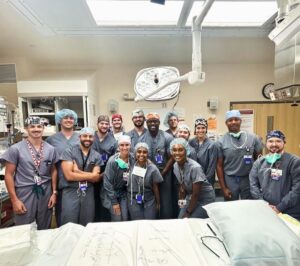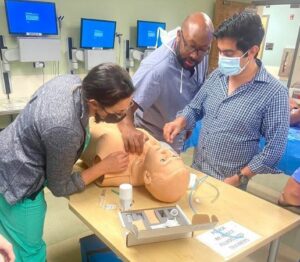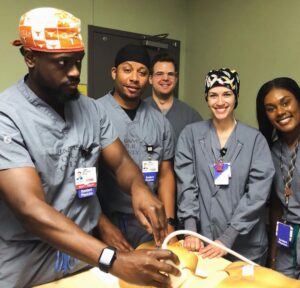Clinical Base (PGY-1)

Our program is designed to meet the educational needs of the resident as well as the requirements of the American Board of Anesthesiology (ABA). The first year of residency requires time spent outside the operating room, training in diagnosis and treatment of other areas of medicine. We have integrated this into our anesthesiology residency by means of joint curricular planning between the Program Directors in Anesthesiology and outside services. For the PGY-1 year, the resident will follow a rotation that includes Perioperative Pain, Emergency Medicine, MICU, Internal Medicine, Surgery, Central Vascular Access/PICC Line, Pulmonary, and Cardiology. Hospitals participating in our PGY-1 year are the UAMS Medical Center, the John L. McClellan Memorial Veteran’s Hospital, Arkansas Children’s Hospital, CHI St. Vincent Infirmary Medical Center, and Baptist Medical Center.
Clinical Anesthesia I, II, III
The Clinical Anesthesia training years provide a comprehensive experience in all aspects of clinical anesthesiology. Emphasis is placed on the development of clinical skills. This is achieved through didactic teaching, diversity of case assignments and extensive experience in the use of modern anesthetic agents and techniques. Many special techniques in monitoring and administration of anesthesia and acute and chronic pain control are taught in the operating and delivery room as well as in the intensive care units and the Ambulatory Care Center. Simulation is used to enhance procedural skills and management from the routine to “never seen”!
Basic Anesthesia Training (CA-1)
The CA-1 year is spent emphasizing basic and fundamental aspects of the management of anesthesia and is focused around preparing for the ABA Basic Examination.
CA-1 residents are involved in complex cases across multidisciplines including General Surgery, Orthopedic Surgery, Neurosurgery, Urology, Otolaryngology, Ophthalmology, OB, and SICU. Supervision is needed to enhance learning and to mentor excellence in patient care.

Subspecialty Anesthesia Training (CA-2)
Residents progress to subspecialty rotations as their next stage in training. Subspecialty training objectives are to achieve the proficiency to provide anesthesia care for a broad range of surgical procedures by in-depth exposure to the specialized areas. Depending on the subspecialty, proficiency is best achieved by scheduled rotations of one to three months. Faculty members with expertise in the various areas provide in and out of OR teaching including lectures and journal clubs. Subspecialty rotations include cardiothoracic, obstetrical, neurosurgery, orthopedic, regional anesthesia and acute pain, chronic pain, pediatric and critical care medicine.

Advanced Anesthesia Training (CA-3)
The goals of advanced anesthesia in the CA-3 year are to provide extensive and in-depth training in subspecialty areas, advanced and complex clinical anesthesia and clinical or laboratory research related to anesthesiology they may have started in the CA-2 year.
Fellowship
Fellowship positions are available in pediatric anesthesiology and our multidisciplinary pain medicine program.
Research
Numerous opportunities exist for research participation. Residents can participate in the development of case reports/series, industry-sponsored drug and device studies, and NIH-funded basic and clinical research.
Areas of research expertise in the department include educational and quality assurance research, pain management studies, and experimental therapeutics. In addition, the department has collaborations with numerous colleges and departments on campus, which can provide other opportunities.
Laboratory research is carried out by faculty members of the Department of Anesthesiology in collaboration with the Department of Pharmacology and Toxicology.
